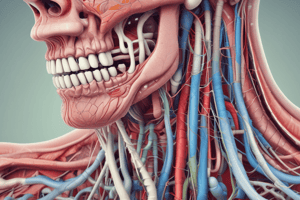Podcast
Questions and Answers
What is the function of myoepithelial cells in salivary glands?
What is the function of myoepithelial cells in salivary glands?
- To produce saliva
- To move secretory products into and through the ducts (correct)
- To regulate blood flow to the gland
- To synthesize digestive enzymes
What type of junctions do serous cells form apically?
What type of junctions do serous cells form apically?
- Adherens junctions
- Gap junctions
- Desmosomal junctions
- Tight and adherent junctions (correct)
What is the shape of mucous cells?
What is the shape of mucous cells?
- Pyramidal
- Spherical
- Columnar (correct)
- Cuboidal
What type of epithelial cells line the intercalated ducts?
What type of epithelial cells line the intercalated ducts?
What is the function of serous acinar cells?
What is the function of serous acinar cells?
What type of ducts drain the secretory acini and tubules?
What type of ducts drain the secretory acini and tubules?
What is the function of the duct system in salivary glands?
What is the function of the duct system in salivary glands?
What is the shape of the serous cell unit?
What is the shape of the serous cell unit?
What is the primary function of saliva?
What is the primary function of saliva?
What is the characteristic of the cells in the striated ducts of salivary glands?
What is the characteristic of the cells in the striated ducts of salivary glands?
What is the characteristic of the excretory ducts of salivary glands?
What is the characteristic of the excretory ducts of salivary glands?
What is the approximate pH of saliva?
What is the approximate pH of saliva?
What is the percentage of total saliva volume secreted by the minor salivary glands?
What is the percentage of total saliva volume secreted by the minor salivary glands?
What is the characteristic of the secretion of the parotid gland?
What is the characteristic of the secretion of the parotid gland?
What is the structure that surrounds each major salivary gland?
What is the structure that surrounds each major salivary gland?
What is the characteristic of the secretory units of the sublingual gland?
What is the characteristic of the secretory units of the sublingual gland?
What is the main function of the pancreas?
What is the main function of the pancreas?
What is the main function of the exocrine part of the pancreas?
What is the main function of the exocrine part of the pancreas?
What is the characteristic of the secretory acini in the pancreas?
What is the characteristic of the secretory acini in the pancreas?
What is the function of the submandibular gland?
What is the function of the submandibular gland?
What is the characteristic of the parotid gland?
What is the characteristic of the parotid gland?
What is the function of the intralobular ducts in the sublingual gland?
What is the function of the intralobular ducts in the sublingual gland?
What is the arrangement of the mucous cells in the sublingual gland?
What is the arrangement of the mucous cells in the sublingual gland?
What is the structure that surrounds the lobules in the pancreas?
What is the structure that surrounds the lobules in the pancreas?
Flashcards are hidden until you start studying
Study Notes
Salivary Glands
- Salivary glands have secretory units of either protein-secreting serous cells or mucin-secreting mucous cells.
- Serous cells are polarized protein-secreting cells, usually pyramidal in shape, with round nuclei and apical secretory granules.
- Mucous cells are columnar in shape, with compressed basal nuclei, and contain apical granules with hydrophilic mucins.
- Myoepithelial cells are small, flattened cells that extend contractile processes around secretory units or ducts, important for moving secretory products into and through the ducts.
Salivary Gland Structure
- Salivary glands are surrounded by a connective tissue capsule, with parenchyma consisting of secretory units on a branching duct system arranged in lobules, separated by septa of connective tissue.
- The secretion of each gland is either serous, seromucous, or mucous, depending on its content of the glycoprotein mucin.
Salivary Gland Functions
- Saliva has digestive, lubricating, and protective functions, with a normal pH of 6.5-6.9, and an important buffering function.
- Saliva is modified by the cells of the duct system draining the secretory units, with Na+ and Cl−, growth factors, and digestive enzymes added.
Types of Salivary Glands
- There are three pairs of large salivary glands: parotid, submandibular, and sublingual glands, in addition to numerous minor or intrinsic salivary glands throughout the oral mucosa.
- Parotid glands have only serous acini and produce a serous secretion.
- Submandibular glands are mixed but have mainly serous acini and produce a seromucous secretion.
- Sublingual glands are mixed but have primarily mucous tubules and produce a mucous secretion.
Duct System
- Salivary secretory units are drained by simple cuboidal intercalated ducts, which merge as simple columnar striated ducts, and further merge as larger interlobular or excretory ducts.
- Striated ducts have mitochondria-lined, basolateral membrane folds specialized for electrolyte reabsorption from the secretion.
- Excretory ducts are unusual in having stratified cuboidal or columnar cells.
Pancreas
- The pancreas is a mixed exocrine-endocrine gland that produces both digestive enzymes and hormones.
- The pancreas has a thin capsule of connective tissue, with septa that separate the parenchyma into lobules.
- The exocrine part of the pancreas secretes pancreatic juice, while the endocrine part secretes hormones.
Studying That Suits You
Use AI to generate personalized quizzes and flashcards to suit your learning preferences.



